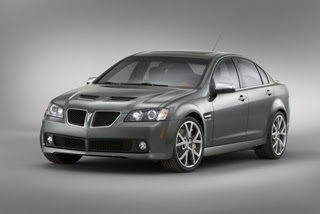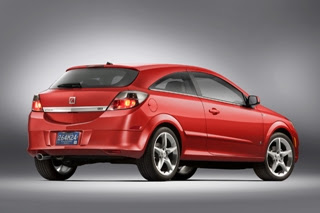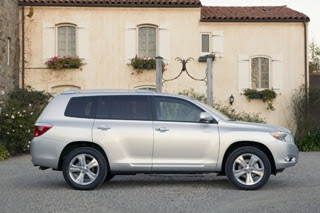The 2007 Chicago Auto Show in Review
2008 Dodge Dakota
The Dodge Dakota is receiving a mid cycle enhancement for the 2008 model year, which consists of a new front end (losing the “baby Ram” look for good; I’m not sure if this restyling is successful…it’s losing some of its personality), new instrument panel, and more power from the 4.7 liter V8 (up 25% to 290 horsepower). At least from the photos, the interior doesn’t impress me – still a lot of hard plastic – but the V8 horsepower upgrade is nice to see.
2008 Ford Taurus/Ford Taurus X/Mercury Sable
One of the first things about the “old way” of doing business at Ford that Alan Mulally, the new CEO of Ford, noted when he joined the company late in 2006 was that he didn’t understand why Ford just abandoned the Taurus name, which at one time was the best selling car in the US. Unfortunately, the Taurus suffered an unsuccessful restyling in 1996 that started to harm sales, and then Ford concentrated most of its energies on the booming truck and SUV market instead. The neglect of the Taurus led to its ultimate cancellation in October 2006, but Mr. Mulally righted a wrong by announcing in Chicago that the previously shown 2008 Ford Five Hundred will instead become the 2008 Ford Taurus; the 2008 Ford Freestyle will become the 2008 Ford Taurus X, and the 2008 Mercury Montego will become the 2008 Mercury Sable, bringing back another successful nameplate from Ford’s history. The functional upgrades to the car are quite good; first and foremost, the Duratec 3.5 liter should move the car much more handily than the old Duratec 3.0 liter, while matching the old 3.0 liter’s fuel economy. The Taurus, Taurus X, and Sable will all be available in front- or all-wheel drive and more than 500 engineering improvements. The new Fords will adopt the Fusion’s and Edge’s three-bar chrome grille, while the Sable adopts some of the Mercury Milan’s styling. Now Ford has to concentrate on getting the word out that these cars are completely different from the Hertz car rental specials that the previous Taurus and Sable had become, and taking advantage of some of the consumer awareness that the Taurus and Sable names still bring to the table.
2008 Nissan Titan/Armada/Pathfinder
This trio of updated Nissan trucks for 2008 made their debut in Chicago. The biggest news was the new availability of a long wheelbase Titan to make the bed more useful in the crew cab (previously, the crew cab had only been available with the very short bed). The long wheelbase Titans will also feature a largest-in-class 37-gallon fuel tank for improved driving range. All three trucks receive revised front and rear treatments, different wheels, and much-improved center stacks. The Armada and Pathfinder receive additional detail updates, such as available hard drive music storage, heated steering wheels, and Bluetooth compatibility. Finally, the biggest news (to Pathfinder fans like me, at least) is the availability of the 300+ horsepower 5.6 liter V8 in the midsize Pathfinder for the first time. I have one with a 4.0 liter V6 and it has decent power, but who wouldn’t love to have a V8? Here’s hoping the fuel economy numbers aren’t much worse with the V8 (which is the same engine used in the much heavier Titan and Armada). I really like the new Pathfinder interior – Nissan definitely attacked the weakest (i.e. cheapest) parts of the 2005-2007 model – and the new features like Bluetooth will be nice to have. The exterior style is very evolutionary. It’s hard to tell the difference unless you look at one in the garage every morning (the new model has slightly different lenses on the taillights and a more swept-back front end).

2008 Pontiac G8 GT
Not stuttering, there are two “G”s in that name, right? The G8 is a left hand drive version of the Australian market Holden Commodore that will be sold in North America as a Pontiac. It is a rear wheel drive, V6 or V8-powered full size car built on GM’s new Zeta global large car platform. The G8 will compete primarily with the Dodge Charger and has a standard 3.6 liter DOHC V6 putting out 261 horsepower, mated to a five-speed automatic (standard on the base car) and an optional 6.0 liter OHV V8 putting out 362 horsepower, teamed with a six-speed automatic or an optional six-speed manual transmission. The G8 show car displayed in Chicago is extremely close to the production model that goes on sale in spring 2008, with the exception of some show car-like features such as a leather-wrapped dash, 20-inch wheels, and a lowered ride height. It’s a good-looking car (fantastic proportions, though the style isn’t very risk-taking) that is reminiscent of the previous generation E46 BMW 3-series from a few angles. The interior looks great, even in high-resolution photos, and let’s face it; the Dodge Charger sets a pretty low bar for the interior’s design and material quality to live up to. Pricing should be pretty similar to the Charger’s. Kudos to GM for not being gun-shy about importing a rear wheel drive Holden after the GTO didn’t meet sales expectations – the G8 should appeal to more buyers because it’s a sedan instead of a coupe, it’s on a great new platform, and it also has a brand new name, meaning it doesn’t have to fill the GTO’s very large shoes. It will basically be replacing the front wheel drive Grand Prix in Pontiac’s lineup, as well as the Bonneville, which was last built for the 2005 model year.

2008 Saturn Astra
2008 Saturn Astra
The Astra is already sold throughout many parts of the world as a Vauxhall, Opel, or Holden, and it’s one of GM’s most successful, best-received small cars. Since Saturn and Opel have started sharing a common design language, and the Ion is more or less the odd man out in the Saturn lineup (the Vue, Aura, Sky, and Outlook are all-new and sort of look like Opels), GM decided to import the Astra as a Saturn from Belgium. While the Astra is certainly a better looking car than the Ion (again, setting the bar pretty low), it will also keep the European Astra’s interior more or less intact: good news for buyers turned off by the Ion’s bizarre center gauge pod. GM has already admitted that the current weakness of the dollar and strength of the Euro will make it “challenging” to turn a profit on Astras sold in the US, but they also claimed that the car will, in fact, be profitable. Here’s hoping that profitability does not come at the cost of de-contenting the car to the point where it’s uncompetitive. Many of the Astra’s competitors are very strong offerings, and have some great features for the class, such as navigation systems (Mazda3 and Civic). It would be a mistake for GM not to at least offer buyers the choice of the whole gauntlet of Astra options available to European buyers, if for no other reason than for the perception of the Saturn brand in buyers’ eyes as a retailer of modern, convenient cars. The European Astra has a choice of several powerplants, ranging from very small, very miserly diesels, to a 240-horsepower turbo. The Saturn Astra will be offered only with a 1.8 liter four cylinder, making 140 horsepower. The car will also be only sold as a hatchback, which is a somewhat risky move on Saturn’s part, but the three door really is a looker. It reminds me a little of the old Ford Focus three door, the way the swoopy rear side window manages to disguise a less-swoopy roofline. The five door is reminiscent of a VW Golf; not ugly, but not as sharp as the three door.
2008 Saturn Vue Red Line/Green Line
The 2008 Saturn Vue was introduced at the 2006 Los Angeles International Auto Show, but both the Red Line (performance-oriented) and Green Line (environmentally friendly) variants made their debut in Chicago. Similar to the changes made to the outgoing model to create the Red Line, the 2008 Red Line is mostly a trim and appearance package, because the Red Line’s 3.6 liter 250 horsepower V6 is already available in the “regular” Vue XR. The Red Line gets leather sport seats with suede inserts, 18 inch wheels, revised front and rear fascias, and sport suspension. The Green Line will go on sale in the fourth quarter of 2007 and will feature a dual-mode hybrid system that improves fuel economy by 50 percent. The current Green Line model has a different, simpler hybrid system called BAS (belt-alternator-starter) which only provides a modest improvement in fuel economy. The 2008 Green Line will have a 2.4 liter four cylinder in addition to the electric motor providing motivation, and is available in only front wheel drive. The Saturn Vue is basically the same as the European market Opel Antara, except it will be built in Mexico instead of Europe, and gets a larger, more powerful engine than the Antara, and a different center stack. Personally, I prefer the Antara’s better-integrated center stack treatment; the Vue has the same “square peg in a round hole” look because GM felt the need to accommodate the corporate radio, which is shared in one form or another with nearly all new models. Overall, the Vue’s styling looks a little too much like a “cute ute” – as if it would fit nicely into the Kia or Hyundai lineup instead of Saturn’s – but we’ll see what the market says about it. I’m sure that at least the loyal Vue owners will want to upgrade.

2008 Scion xB
2008 Scion xB/xD
Toyota’s successful Scion brand introduced two new models at the Chicago show. First was the second generation of the xB, which is the “box on wheels” Scion. The new xB is larger than the outgoing model and trades some of its boxiness for a more familial Scion look (think of it as a taller, boxier, four door take on the tC coupe’s styling cues). It seems to sit closer to the ground than the old xB. The xD, which replaces the xA as a “five door urban subcompact” in Toyota’s words (the xA was Scion’s weakest link in terms of sales – only 32,603 units were sold in 2006 – so that’s probably why they decided on a name change. The xB continues with the ridiculous center-mounted gauge cluster, but the xD moves the gauges behind the steering wheel, in front of the driver, where they belong. The new xD is powered by a 1.8 liter 128 horsepower four cylinder, coupled to either a five-speed manual or four-speed automatic transaxle, and the new xB is powered by the same 2.4 liter 158 horsepower four cylinder found in the popular tC – an increase of 55 horsepower over the previous xB. Both new Scions have upgraded Pioneer audio systems standard, catering to their intended younger audience (though last time I heard, it wasn’t just “kids” buying Scions – plenty of baby boomers like them because they’re simple, reliable, and easy to enter and exit). I think the tC is a great little car – attractive, priced aggressively, lots of standard equipment. But Scion seems to be trying almost too hard to make the xB and xD frumpy-looking with skinny tires, plastic hubcaps, and few if any exterior decoration.

Toyota Scion xD
The official photos of the xD include a few of one with large aluminum wheels (probably about 18-19 inches) and few other exterior decorations, but the car looks ten times better. Almost like a poor man’s Mazda3, and that’s a good thing. Scion probably wants buyers to hate the way the base models look so much that they have no choice but to purchase dealer-installed accessories to spruce up the appearance of their vehicles.

2008 Toyota Highlander/Highlander Hybrid
The second-generation Toyota Highlander finally made its public debut in Chicago, and also managed to grow a few inches (and a few hundred pounds), as many expected. The RAV4’s third generation re-do for 2006, which included an available V6 and small third-row seat for the first time, pretty much ensured that its big brother would need to bulk up to keep up. To me, the exterior looks very much like Toyota’s other truck offerings – it shares some cues with the RAV4 (front end) and Sequoia (back end), with a greenhouse shape similar to the outgoing model’s. The exterior style isn’t its strong point, but it is definitely an improvement over the 2007 model. Inside, the designers at Toyota managed to create a classy, attractive instrument panel (though the gauge cluster is a little too “out there” for my taste), and have thrown some really nice features, either standard or optional: Bluetooth cell phone connectivity, third row seat, 5,000 pound towing capacity (class-leading for crossovers), and a backup camera/info display screen not tied to a navigation screen (standard on all but the base model). Under the hood is a new 3.5 liter V6 in the same family as the Camry’s optional engine, putting out 270 horsepower in this application, coupled to a five-speed automatic. I’m surprised that Toyota is only using a five-speed in its 2008 Highlander, considering that they already have a six-speed automatic on the shelf for the Camry, and the Highlander’s closest competitors, the GMC Acadia and Saturn Outlook, both come standard with six-speeds. Still, the Highlander is a little smaller and a few hundred pounds lighter than the GMs, so even with one fewer gear and five fewer horsepower, it should really be pretty fast. Highlander sales (excluding the Hybrid) were down almost 18% in 2006, but I wouldn’t be surprised to see some of that shortfall made up next year. The 2008 Highlander goes on sale in July 2007.
The Chicago show did not have the same quantity and quality of new model introductions that we saw in Detroit and Los Angeles this season, but the Scions and Highlander should be strong sellers for Toyota; Ford will hopefully find some of its Taurus mojo with the Five Hundred’s name change, and Saturn will continue its momentum with the extensions of the Vue lineup and the debut of the Astra. See you in New York!




